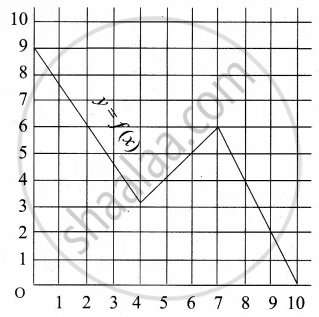Advertisements
Advertisements
प्रश्न
Find the set of values of x for which the functions f(x) = 3x2 − 1 and g(x) = 3 + x are equal.
उत्तर
It is given that the functions f(x) = 3x2 − 1 and g(x) = 3 + x are equal.
\[\therefore f\left( x \right) = g\left( x \right)\]
\[ \Rightarrow 3 x^2 - 1 = 3 + x\]
\[ \Rightarrow 3 x^2 - x - 4 = 0\]
\[ \Rightarrow \left( x + 1 \right)\left( 3x - 4 \right) = 0\]
\[\Rightarrow x + 1 = 0 \text{ or } 3x - 4 = 0\]
\[ \Rightarrow x = - 1 \text{ or } x = \frac{4}{3}\]
Hence, the set of values of x for which the given functions are equal is \[\left\{ - 1, \frac{4}{3} \right\}\] .
APPEARS IN
संबंधित प्रश्न
Find the domain of the function f(x) = `(x^2 + 2x + 1)/(x^2 - 8x + 12)`
Let A = [p, q, r, s] and B = [1, 2, 3]. Which of the following relations from A to B is not a function?
If \[y = f\left( x \right) = \frac{ax - b}{bx - a}\] , show that x = f(y).
Let f and g be two real functions defined by \[f\left( x \right) = \sqrt{x + 1}\] and \[g\left( x \right) = \sqrt{9 - x^2}\] . Then, describe function:
(i) f + g
Write the range of the real function f(x) = |x|.
If f is a real function satisfying \[f\left( x + \frac{1}{x} \right) = x^2 + \frac{1}{x^2}\]
for all x ∈ R − {0}, then write the expression for f(x).
If f, g, h are real functions given by f(x) = x2, g(x) = tan x and h(x) = loge x, then write the value of (hogof)\[\left( \sqrt{\frac{\pi}{4}} \right)\] .
Which one of the following is not a function?
If f(x) = cos (log x), then the value of f(x2) f(y2) −
Let f(x) = |x − 1|. Then,
If \[f\left( x \right) = \log \left( \frac{1 + x}{1 - x} \right)\] , then \[f\left( \frac{2x}{1 + x^2} \right)\] is equal to
The range of the function \[f\left( x \right) = \frac{x^2 - x}{x^2 + 2x}\] is
The function f : R → R is defined by f(x) = cos2 x + sin4 x. Then, f(R) =
The range of the function \[f\left( x \right) = \frac{x + 2}{\left| x + 2 \right|}\],x ≠ −2 is
If f(x) = `{(x^2 + 3"," x ≤ 2),(5x + 7"," x > 2):},` then find f(3)
Which sets of ordered pairs represent functions from A = {1, 2, 3, 4} to B = {−1, 0, 1, 2, 3}? Justify.
{(1, 2), (2, −1), (3, 1), (4, 3)}
Check if the relation given by the equation represents y as function of x:
x + y2 = 9
Check if the relation given by the equation represents y as function of x:
3x − 6 = 21
If f(m) = m2 − 3m + 1, find f(0)
Find x, if g(x) = 0 where g(x) = x3 − 2x2 − 5x + 6
Express the following logarithmic equation in exponential form
log10 (0.001) = −3
Express the following logarithmic equation in exponential form
`log_(1/2) (8)` = – 3
Solve for x.
2 log10 x = `1 + log_10 (x + 11/10)`
Select the correct answer from given alternatives.
Find x, if 2log2 x = 4
Answer the following:
If f(x) = 3x4 – 5x2 + 7 find f(x – 1)
Answer the following:
Find x, if x = 33log32
Answer the following:
Show that, `log |sqrt(x^2 + 1) + x | + log | sqrt(x^2 + 1) - x|` = 0
Answer the following:
Solve : `sqrt(log_2 x^4) + 4log_4 sqrt(2/x)` = 2
Given the function f: x → x2 – 5x + 6, evaluate f(2a)
A graph representing the function f(x) is given in it is clear that f(9) = 2

Find the following values of the function
(a) f(0)
(b) f(7)
(c) f(2)
(d) f(10)
The data in the adjacent table depicts the length of a person's forehand and their corresponding height. Based on this data, a student finds a relationship between the height (y) and the forehand length (x) as y = ax + b, where a, b are constant.
| Length ‘x’ of forehand (in cm) |
Height 'y' (in inches) |
| 35 | 56 |
| 45 | 65 |
| 50 | 69.5 |
| 55 | 74 |
Find the height of a person whose forehand length is 40 cm
The function f and g are defined by f(x) = 6x + 8; g(x) = `(x - 2)/3`
Write an expression for gf(x) in its simplest form
Let A = {1, 2, 3, 4} and B = N. Let f : A → B be defined by f(x) = x3 then, find the range of f
Find the range of the following functions given by f(x) = `3/(2 - x^2)`
Let f(x) = `sqrt(x)` and g(x) = x be two functions defined in the domain R+ ∪ {0}. Find (f – g)(x)
Let f(x) = `sqrt(x)` and g(x) = x be two functions defined in the domain R+ ∪ {0}. Find (fg)(x)
Let f(θ) = sin θ (sin θ + sin 3θ) then ______.
The period of the function
f(x) = `(sin 8x cos x - sin 6x cos 3x)/(cos 2x cos x - sin 3x sin 4x)` is ______.
